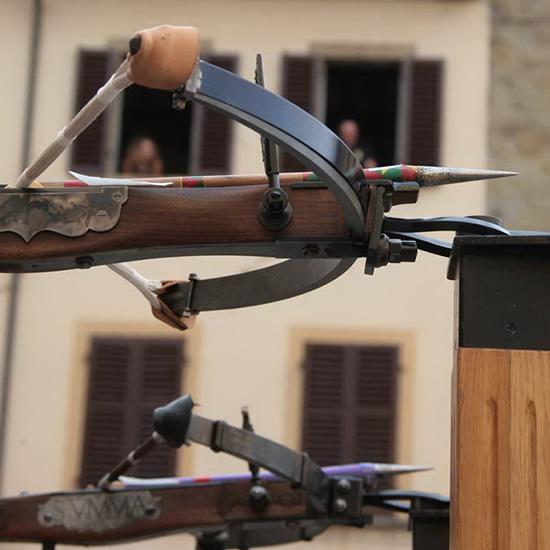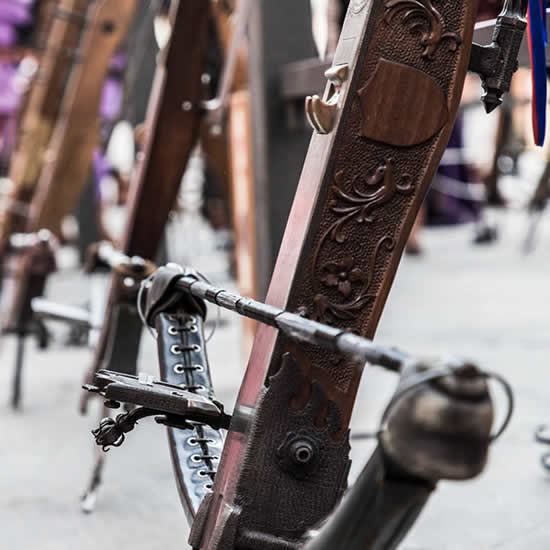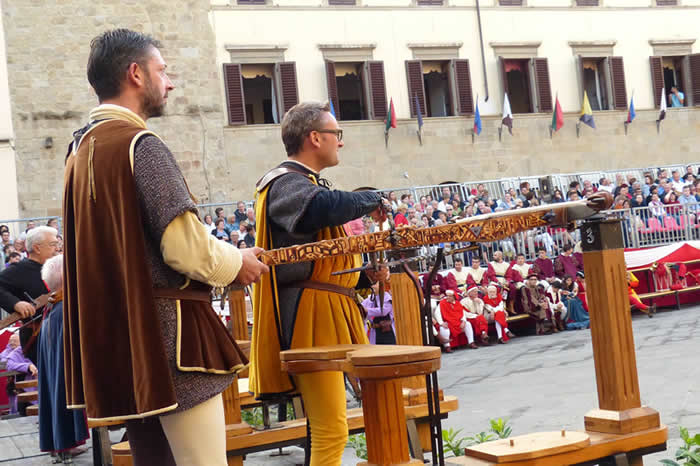The Balestra
For centuries without interruption, Gubbio and Sansepolcro, and their crossbowmen, have competed twice a year for the Palio della Balestra® in honour of their patron saints, Ubaldo, Egidio and Arcano: the last Sunday of May in Gubbio and the second Sunday of September in Sansepolcro. The Palio is governed by an ancient code ratified in 1619.

Te crossbow, a lethal stationary weapon used in bloody conflicts, has today become an instrument for gathering, friendship and brotherhood between Umbria and Tuscany.
The crossbow consists of a steel bow at the tip of a wooden shank called the "tinier" or "Teniers", a cord secured at the end of the bow, a loading mechanism and an aiming system.
When the bowman fires, the cord held by the "nut" (a stable loading hook) powerfully releases all the energy stored by loading the bow (the bow is loaded by a winch called a "martinetto" or "baldric") and shoots the arrow towards the target, known as the "corniolo" consisting of a wheel with a protruding conical trunk. The centre is three centimetres in diameter, with a metal plate in the centre called the "bulletta" or "pulsone". The regulatory distance between the firing station and the target is 36 metres.
The arrows fired from the crossbow are also known as "Ferretto", "verrettoni" or "puntadure". These consist of a turned wood shank with a metal tip and two feathers or "timoni" at the other end.
The bowmen are encouraged by the motto: "shoot the Palio with virtue and honesty, and may victory smile upon the best of the field".
The Italian History of the crossbow
Extract from the book "Il Palio della Balestra a Sansepolcro" by Mariangela Betti and Giovanni Tricca
The crossbow, a weapon used to launch various projectiles - arrows, daggers or stones - can be considered the ultimate form of the bow, with the addition of a wooden shank, called a tiller, which serves as a handle and to add extra power to the shot.

Its origins are extremely ancient. The first evidence of the crossbow is in a Chinese object dating back to the Han dynasty (206 BC - 220 AD), and indirect literary documentation, also in China, from the late 6th century BC. The crossbow was known to the Assyrians, Balylonians, Greeks and Egyptians. It is likely that examples of Chinese crossbows reached Europe during Persian military campaigns, and became common enough to be known to the Romans, who adopted the crossbow as a weapon of war during the early part of the Empire.
However, the Romans used a particular type of crossbow, the arcubalilsta, for their raids, as evidenced by several finds in Great Britain dating back to 54 BC. indicating the presence of crossbowmen in the legions of Caesar.
Along with the arcuballista, the Romans also used the scorpio, "so named", according to Vegetius, "because they brought death with small, slim arrows".
In any case, by the end of the Empire, every centuria had a crossbow mounted on a carriage and operated by 11 soldiers.
The stones launched by this machine could destroy the crenellations of walls and eliminate the entire front line of a military phalanx.
Soldiers also used this fearful weapon to launch other projectiles: metal daggers, arrows and sometimes lighted torches.
There is no more information about the use of the crossbow until the 10th century, when they were used widely for defence and attack, right up until the arrival of firearms.
We know that William the Conqueror used crossbows during his army's invasion of England in 1066. Teams of crossbowmen were a regular feature during the first Crusade (1096-1099). Genoa sent archers and crossbowmen to the Holy Land headed by William the Drunkard (AKA Mallet Head), and Pisa established a corps of bowmen led by Archbishop Daiberto.
The successful use of the crossbow in the Holy Land encouraged its spread throughout the western world; however, in view of the increasing use of poisoned arrows, which made the weapon even more lethal, its use was outlawed by the anathema of Pope Innocent II during the Second Lateral Council in 1139: "illam mortiferam artem et Deo odibilem Ballistariorum et Sagittariorum adversus Christianos et Catholicos exerceri de cetero sub anathemate prohibemus".
Although the ban only applied to the use of the crossbow against Christians, the excommunication was ignored from the outset and, to the serious detriment of soldiers, the crossbow became the favourite weapon of European armies (the Genoese in particular gained a great reputation for their skill in its use), to the extent that a clause in the Magna Carta banished foreign bowmen from the kingdom, deeming them responsible for numerous uprisings due to their arrogance in the possession of such a dangerous weapon.

In 1003, for example, a certain Vittore Ricucchi led the Pisan army against the king Musetto in Sardinia, during which several crossbowmen showed great valour in the attack on Olbia.
With the rise of the free city-states and the establishment of citizens' armies, the crossbow was used not only on the battlefield but also during periods of peace, in competitions organised mainly on feast days; clearly these events provided opportunities for the citizens to remain practised in its use.
Reports of the first "People's Army" and its activities are found in the municipal laws of Pisa in the year 1162, which stipulare that in times of peace, a captain should provide weapons training for the men in several disciplines: crossbow shooting, spear throwing and the Sardinian staff. Target practice thus became an integral part of military training for city armies. From 1158, the Republic of Genoa had organised companies of archers and crossbowmen against Barbarossa; these were so numerous that the daily cost of feeding the men amounted to 100 silver pieces (3).
In 1245 Genoa was in a position to send 500 crossbowmen to help the Milanese in their campaign against the emperor Frederick II; these were so skilled that they were assigned the most dangerous positions.
However, following an unexpected attack by King Sino, the emperor's illegitimate son, on the Milanese army, many soldiers were taken prisoner, including the Genoese crossbowmen. In the hands of the enemy, these paid dearly for their courage and skill: "each of the Genoese crossbowmen had one hand cut off and the right eye gouged out; after some time they were freed and returned to Genoa, where the Republic established provision for their lifetime, under the auspices of the Municipality.
The expertise of the Genoese crossbowmen is also evidenced by the presence of 15,000 of them under the command of Carlo Grimaldi and Aitone Doria at the battle of Crécy (26 August 1346) between King Philip VI of France and Edward III of England.
In spite of their prowess, during this battle they were defected due to adverse circumstances: while travelling to the battlefield, rain made the crossbows unusable, the bowmen were felled by English arrows and the survivors, deemed traitors, were slaughtered by order of Philip VI. In the 12th century, the rulers of San Marino authorised the construction of stationary and manual crossbows, and later the San Marino Arengo ordered the consuls to acquire during their six-month term a large crossbow with 24 daggers and a robust frame (5) of either bone or wood, to be delivered to the administrators (6) of the comune.
In 1250, Florence also established its own city militia, with mounted and foot soldiers; the noblemen and wealthy citizens fought on horseback, while the commoners were on foot. Every man aged between 15 and 70 was "described" in the city's army. Each company had its own weapons: 20 crossbows, 20 spears and 20 axes; the 20 crossbows had to include four large ones, on two feet or rotating. In times of war, only the crossbowmen considered appropriate in terms of age or skill were called to arms.
These were chosen by the captains of the city's militia, which was divided into six companies, corresponding to the "sesti" of Florence. Each company had to be supplied with large crossbows, and certain officers were appointed "ad portandum etconducendum balistas grossas". One of these officers is named in the Sesto d'Oltrarno: Armoleo, son of Bonizio Sarti from Borgo Sansepolcro.
With this military structure, the Florentine crossbowmen took part in the battle of Montaperti, and from then on they were a regular part of the attack force in the later battles of Colle Vai d'Elsa (1269) and Campaldino (1289) (8).
In France, under the reign of Louis V, the crossbow militia were so respected that the position of "maitre d'arbalétriers" was established, which only ended in 1534 with the death of the last great bowman, Aymone de Brie (9).
Also in France, in the 14th century, Giuliano of the Dotti family of Borgo Sansepolcro was appointed first colonel and later general of the King's Archers (10).
Around the middle of the 14th century, a crisis arose in the city militia, following the arrival of mercenary soldiers. The event was sparked by the remarkable economic and social development of the city, due to the increase of trade and business.
The city was redeveloped and a series of orders prioritised the economy and wealth equally with the need for military defence.
The citizens were already engaged in various profitable activities and trade in order to increase their wealth, and were increasingly unwilling to actively contribute to the city's militia; hence the need to draw on a new type of army and recruit professional soldiers. This gave rise to specialised companies which, although composed of paid soldiers, nevertheless succeeded in creating an effective force and also perfected the art of war and the use of certain weapons. However, the citizens remained willing to intervene in the event of serious danger which would threaten their business activities. This is seen in Florence where, in 1356, an order was issued to recruit 400 crossbowmen (11), provided with helmets, armour, swords and crossbows with ten daggers or pointed arrows/. Each month they had to display these weapons.
The decree also established the obligation to "form up (12) and acquire and retain the experience of forming up in the places and at the times ordered by officers appointed for such purpose, on pain of sanctions to be determined by said officers..." (13).
In his Chronicles, Matteo Villani added to this: "...for each inspection the officials ordered for every division a noble and beautiful crossbow and three arrows, which was offered as a prize and honour to the crossbowman of the company who beat the others in shooting three arrows at the target; and they did the same in the communes of the county to train the men, seeking honour and skill with the crossbow, and this was the cause of great activity with the crossbow, so much so that in the city and the county, every feast day the crossbowmen came together to compete and enjoy this singular sport" (14).
A decree of this type was motivated by the grave threat posed to the Republic of Florence by the army of Count Lando, which was about to arrive in Tuscany from Romagna. From the city and the county, the Republic managed to gather 2500 expert crossbowmen armed and armoured who were sent to the Apennine mountain passes and halted the advance of the army, who "seeing the Republic of Florence so well armed, abandoned their plan to enter Tuscany and moved to negotiate with the Lords of Lombardy" (15).
The extreme ease with which Florence was able to gather 2500 "expert crossbowmen" in a short time, which in time grew to 4000, indicates the wide diffusion of this weapon among the people, who became practised in its use.
Information about the preparation of crossbowmen is also found in the municipal records of the city of Orvieto, which tell us that in the 14th century the register of crossbowmen was regularly updated by the captain, aided by seven advisors. The register was later kept with other public documents in the church of San Giovanni. When needed, the Orvieto crossbowmen were called up by random selection of their names and posted as guards of the city or other duties. The selection by lot continued until everyone was called, so that every citizen took a turn as a crossbowman in defence of the city.
As a city militia, the crossbowmen were not paid a salary, but received wages when required to serve.
The necessary training we have seen established by the Florentine decree was also practised in many other Italian cities.
The statutes of the city of Cremona in 1270 appoint the captain of the militia, chosen in each district, to bring together the men under him once a month, on a feast day, and take then "after dinner to the place named il Ceppo to practise in weapons" (18).
In Pisa in the second half of the 13th century, citizens would train on Sundays in "target practise" with bows and crossbows, leading the town hall to issue a decree banning this in certain places: "may no man dare to fire a bow or crossbow or play any other game in the churches of S. Maria and S. Giovanni, or in any circumstances at a distance less than ten rods" (19). Pisan crossbowmen "are obliged every Sunday to practise with crossbows near the city walls and in other solitary places".
In Genoa, in further confirmation of the popularity of shooting practise, the municipality acquired a piece of land in 1352 from the Abbey of S. Stefano for this activity, and in 1386 paid 25 lire for four silver cups to be given as prizes "to two crossbowmen appointed by the militia for skill with the crossbow" (21).
In 1423 the town of Recanati approved the celebration of the feast of S. Vito, protector of the town, and the Nativity of Mary, with crossbow shooting games.
In 1443, Lucca also established target shooting with the crossbow: on 29 June the Magnificent Elder Lords and the Standard Bearer of Justice decided that every year on the first of May and September, the city would prepare and pay for four prizes worth a total of 18 coins, to be awarded to the best crossbowmen in target shooting.
In that period a roundel with a target was set up in the courtyard of the palace: "the crossbowmen, at a distance of one hundred paces from the target, will shoot (22) only one time each" (23).
It was later decided that the arrows used should bear the name of the bowman, and the organisers of the contest, "inspecting the target, will take the four arrows closest to the centre or actually piercing it", as "the arrow stuck in the centre is the best shot". In the event that a second arrow strikes and breaks the shaft of one already stuck in the bullseye, making it impossible to know the name of the first bowman, the second "when known for sure to whom it belongs, will have the prize, and the first shall not blame the law but bad luck".
The rules stipulated that the contest was only open to citizens of Lucca and its county who were owners of crossbows and arrows. Anyone cheating was fined two ducats. The Lucca rules once again prove that the habit of target shooting was carried out in order to arm citizens suitable for war and prepare them to defend their city. The regulations were changed in 1490, when it was decided to hold four competitions a year, two with the crossbow and two with musket and arquebus. This was the beginning of the age of firearms. Nevertheless, the crossbow continued to be part of European armies for a long time: for example, 200 crossbowmen on horseback fought with Francesco I in the battle of Marignano in 1514, against the Sforza rule.
The most recent report of crossbows used in battle was during the attack on Turin in 1536, which mentions a crossbowman who alone killed more enemies than the arquebus (24). But although the crossbow was destined to disappear as a weapon, its use in peacetime remained, and is still with us.
In fact, after the invention of firearms, the scarcity of these weapons meant not everyone could use them, the relative ease of obtaining crossbows allowed their use for shooting practise continued. What's more, even when battlefields began to be dominated by firearms, the crossbow was still used for technical reasons: "the musket shooter needed a stand to rest the weapon on, and had to carry the fuse and fire-making equipment; in fact, the operation was so complicated that the crossbowman could fire two or three arrows in the time it took to prepare and fire the musket. And it was common that the musket became useless on long marches, to the extent that it only began to replace the crossbow after the mid-16th century, when the bayonet was added".
The fashion for new weapons, however, soon became a feature of popular contests. In 1542, San Marino established games with prizes for musket shooting and, to continue the ancient tradition and expand target practise to include the new weapons, the Statutes of the Republic in 1600 established that every year on the day of 1600 established that every year on the day of 5 S. Marino, a competition would be held for shooting with both crossbows and muskets.
Ongoing technical and military progress meant that muskets were soon overtaken and disappeared, while the crossbow continued to be part of the traditions and festivals of many towns and cities. Today crossbow shooting competitions are still part of the heritage in many places: Gubbio, Lucca, Massa Marittima, S. Marino and Sansepolcro.
Founded as military practise for citizens' militias or army companies, who defended the freedom and independence of the medieval city states, these later became established as competitions and governed by ancient rules and statutes. Among the numerous documents bearing witness to the traditional Palio della Balestra in Gubbio on the day of S. Ubaldo is a report from 1461:
"On Sunday the crossbow contest was held, and the company of Santa Croce went with many ladies to accompany Madonna (Batista Sforza) to watch the shooting" (26). In archive documents from San Marino there are "Capituli del palio" dating back to 1537, which establish the regulations for the contest and the list of arbequs shooters and crossbowmen.
In Lucca, documents from 1443 outline the regulations for crossbow competitions.
In Massa Marittima a document dated 1476, and preserved in the municipal archive, establishes the "a contest is held every three months. So that the youths may take praiseworthy exercise, it is established that four times yearly, every three months, the crossbow is fired three times, that is in three orders, and whichever of the three hits the target most will be awarded a steel crossbow with pivot, provided he is from Massa or resident in Massa and not otherwise and two of these crossbows will be paid for by the city of Massa and the other two by the Podestà, each Podestà paying for one; in this way the young men will be distracted from hunting and attracted to the praiseworthy exercise of the crossbow, which might be useful in times of need" (27).
The advent to firearms interrupted the traditional Palios in Lucca and Massa Marittima.
In San Marino there were crossbow competitions until 1852 when the disorder and strife caused by the recent passage of Garibaldi led the Pope's ambassador to "temporarily" suspend the activity.
Only in Gubbio and Sansepolcro has crossbow shooting been practised without interruption to the present day and has led to thrilling palio events, as evidenced by the success and fame of those held in Piazza Torre di Berta in Sansepolcro, where every year the spectators watch bowmen in 15th century costume and experience the same excitement as that felt in the days of Piero della Francesca.
History of the Crossbow in the world National
341 BC The first reliable mention of crossbow use in the battle of Ma-Ling, China.
228 BC The remains of a crossbow and, previously, a bronze locking mechanism, are found in the tomb of Yu Wang.
300-700 AD Roman sculptures of crossbowmen
c. 1000 AD The crossbow becomes widely used in the west.
1066 AD Skilled crossbowmen accompany William the Conqueror on his invasion of England
11339 AD The Lateran Council and Pope Innocent II ban the use of crossbows against Christians, declaring them "deathly and hateful to God and unfit to be used among Christians".
1192 AD Victory of the Crusades in Jaffa, aided by the crossbow
1314 AD Earliest reliable record of a steel lath
1346 AD Genoese crossbowmen defeated by English archers at Crécy
1503 AD First of a series of English laws limiting the possession and use of crossbows
1550-1600 Firearms replace crossbows in most western armies; modified crossbows for sports use are still popular in hunting
1650 AD Shooting competitions with crossbows become popular
1700-1800 Chinese develop a self-loading crossbow
1860 AD Photographic evidence is found in China of the automatic crossbow still used as a weapon of war
1939-1945 A fast-shooting crossbow is used by Australian commandos in the Pacific
1945-1975 Crossbows used by the Montagnards and US special forces during the Vietnam War
1960 - present The crossbow is used to shoot anaesthetic darts at wild animals; it is also used to obtain tissue samples from sea animals in order to study genetic information.

